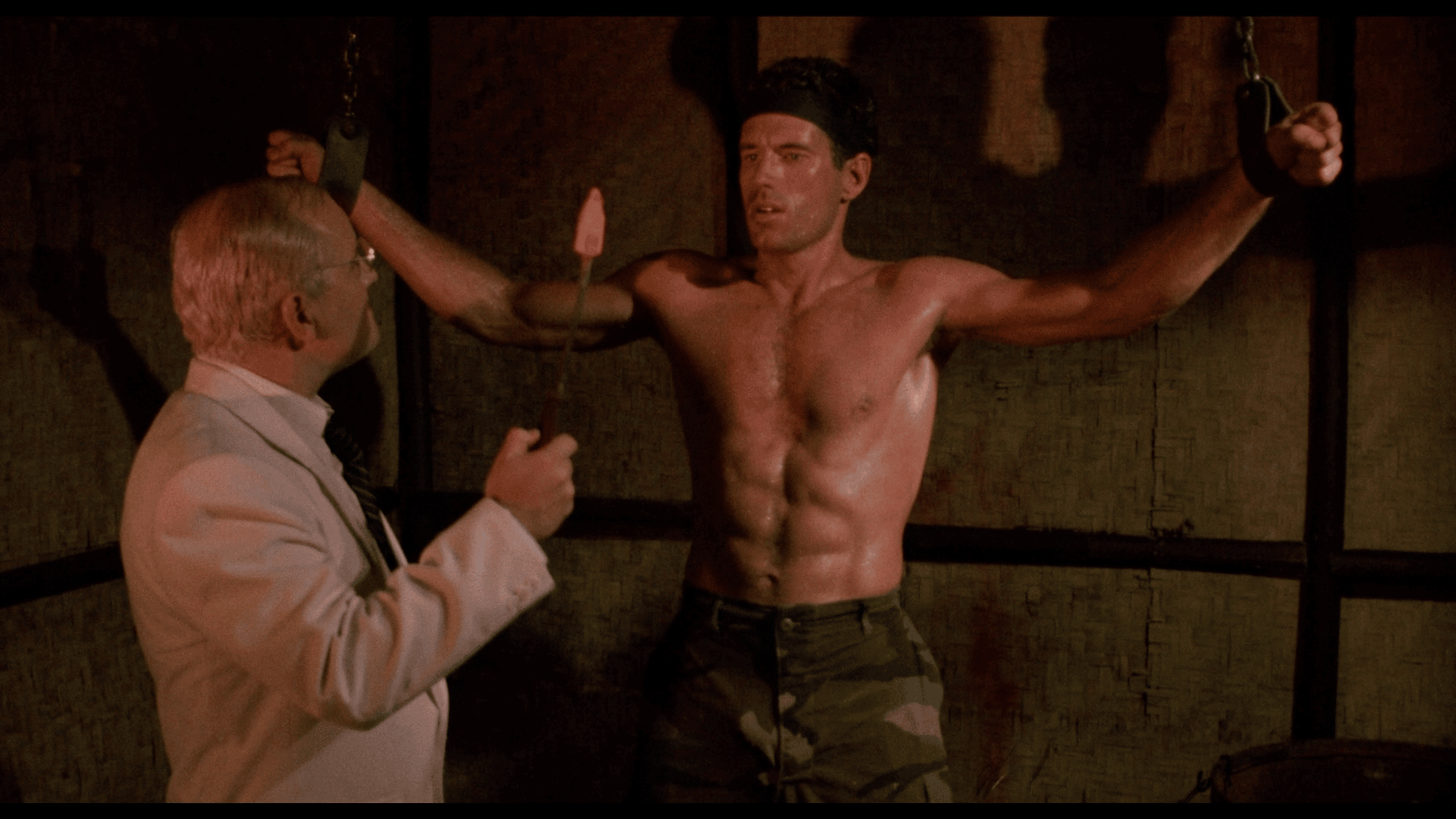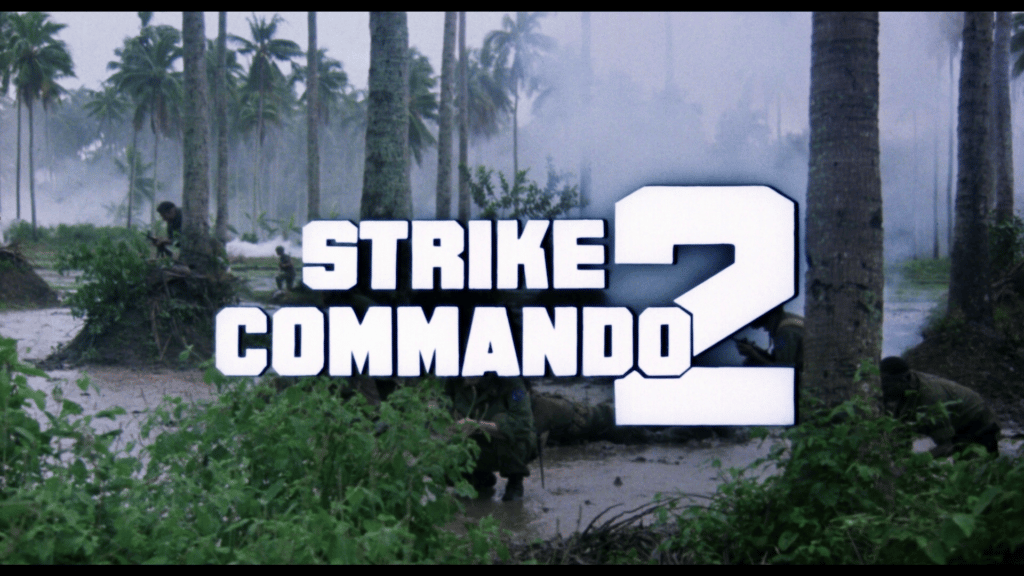
Motivated by the popularity of 1986’s Strike Commando, the first of a number of films they shot in the Philippines, Bruno Mattei, Claudio Fragasso and producer Franco Gaudenzi sought to emulate its success by making a sequel, Strike Commando 2 (Trappola diabolica), released in 1988. Along with the first film, Strike Commando 2 has been given an impressive Blu-ray release by Severin Films – though we recommend reading this review of Strike Commando 2 in conjunction with our article about Strike Commando, which establishes a context for the ‘macaroni combat’ films of the 1980s – and in particular, the trend in ‘Namsploitation’ pictures, shot in the Philippines, popular with Italian filmmakers following the successes of Cimino’s The Deer Hunter and Coppola’s Apocalypse Now.
In the interview on Severin’s release of Strike Commando 2, Claudio Fragasso talks about Bruno Mattei’s predilection for copying wholesale scenes from popular Hollywood movies. Where Strike Commando was clearly modelled on Rambo: First Blood, Part II (George P Cosmatos, 1985), with some overt nods to other pictures – for example Antonio Margheriti’s The Last Hunter (L’ultimo cacciatore, 1980), the progenitor of the Italian ‘Namsploitation’ films made in the Philippines during the 1980s – Strike Commando 2 takes more inspiration from other Hollywood films: in particular, Steven Spielberg’s Raiders of the Lost Ark (1981), the clear influence of which Strike Commando 2 bolts onto its Rambo-esque narrative structure.
In Strike Commando 2, Ransom (Brent Huff) is introduced mourning for the death of his former commanding officer, Major Vic Jenkins (Richard Harris). However, Ransom soon discovers that Jenkins’ death has been faked: Ransom’s mentor is alive, and being held in a CIA safehouse. Ransom attempts to free Jenkins, but his rescue attempt is interrupted by another group of men, who overwhelm the CIA agents and manoeuvre Jenkins away in a helicopter.
A ransom of $10 million in diamonds is demanded by the captors for Jenkins’ safe return. Ransom is tasked by CIA agent Peter Roeg (Paul Holmes) with journeying into the jungle and bringing Jenkins back – dead or alive. Jenkins, it seems, is being held by a group involved in the manufacture of heroin, which Ransom is told is led by Huan To (Vic Diaz), a Chinese KGB agent with a penchant for sexual sadism.
Along the way, Ransom stops off at the tavern of Rosanna Boom (Mary Stavin). However, he has been pursued by the sinister white-suited Kramet (Mel Davidson) and his team of black-clad ninjas(!), who destroy Rosanna’s drinking establishment. Rosanna and Ransom escape to the jungle and team up, Ransom promising to aid Rosanna in establishing a new business elsewhere.
Ransom infiltrates Huan To’s compound but is captured and tortured by Kramet. Nevertheless, Ransom manages to escape and rescue Jenkins – only for Jenkins to turn his gun on Ransom, revealing that it is he who is really behind the heroin operation, and Huan To is his associate and not his captor.
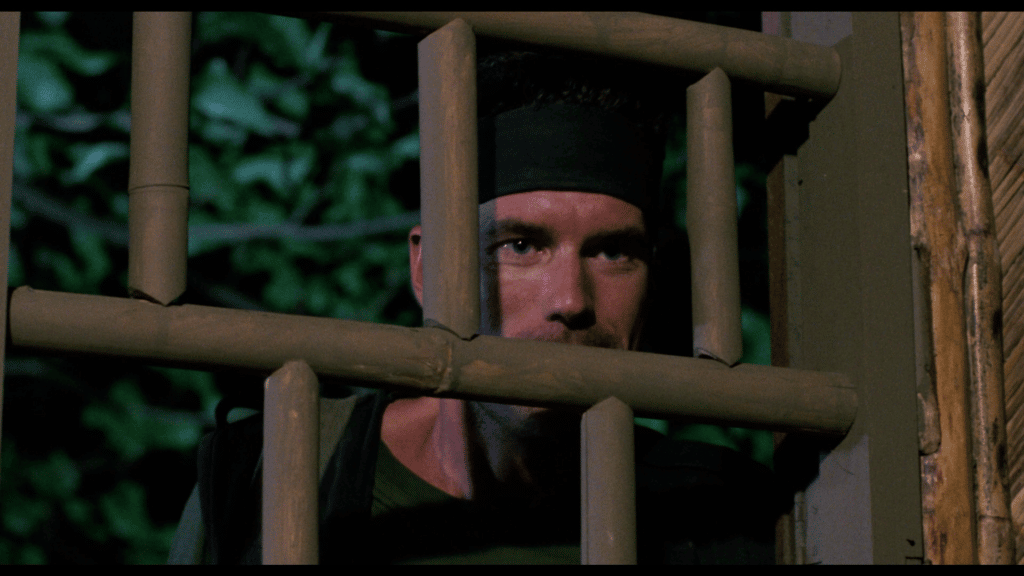
Though the film is positioned as a direct sequel to Strike Commando, misleadingly featuring the likeness of Reb Brown on its poster and video art, Strike Commando 2 is its own beast of joyful absurdity. The character of Ransom (played by Reb Brown in the first film) returns, but here he is played by Brent Huff, who is of a very different appearance to Reb Brown: most obviously, Brown, who had played Captain America in the television movies of the late 1970s, was at the time known for his wavy blonde hair; whereas Huff’s hair is much darker, and more tightly cropped. (Truth be told, of the two actors, wearing his bandana and hip-firing an M60 on full auto, Huff bears a closer resemblance to Stallone… just. Actually, Huff bears a striking similarity on-screen to Paul Michael Glaser.) Huff would go on to work with Mattei on two further films shot in the Philippines: Cop Game (Giochi di poliziotto, 1988) and Born to Fight (Nato per combattere, 1989).
Strike Commando 2 was filmed essentially back-to-back with Claudio Fragasso’s Zombi(e) 4: After Death (Oltre la morte, 1989). Scenes for Strike Commando 2 would be shot during the day (chiefly by Mattei), and footage for After Death would be shot at night by Fragasso. (In the interview on this disc, Huff says that this caused some problems for his love life, as at the time he was dating Candice Daly, who was one of the principal actors in After Death. Daly and Huff would go on to star together in Mattei’s Cop Game.) This enabled camera equipment to be shared by the two productions – along with a number of key crewmembers, including makeup artist Franco Di Girolami, art director Vic Dabao, production manager Giovanni Paolucci, and production supervisor Manrico Passerotti, as well as some of the stunt crew (stunt co-ordinator Ottaviano Dell’Acqua and stuntman Dante Abedeza) and camera team.
Both films were scripted by Rosella Drudi. (There’s a thesis to be written about Drudi and fellow screenwriter Elisa Briganti’s contributions to the sphere of largely male-dominated Italian exploitation films of the late 1970s and 1980s.) Interviewed on Severin’s release of Strike Commando, Drudi said that Mattei and Fragasso, both of whom were credited as writing the story and script of that film, contributed ideas – mostly, in Mattei’s case in particular, derived from scenes in popular American movies of the period – and Drudi cobbled together a screenplay without onscreen credit.
Here, in the interview on Severin’s release of Strike Commando 2, Fragasso says that in pre-production meetings, Mattei would sit with Fragasso and Rosella Drudi ‘and start ripping off dialogue and scenes from famous films. We kept telling him you can’t just copycat a movie from start to finish, dialogue included, because that’s not how the creative process works [….] I told Bruno that we shouldn’t just copy but take inspiration instead’. However, according to Fragasso, Mattei would watch ‘a film over and over, noting down what to copy, with me telling him he couldn’t do that [….] To totally rip off other movies, that was his spirit’.
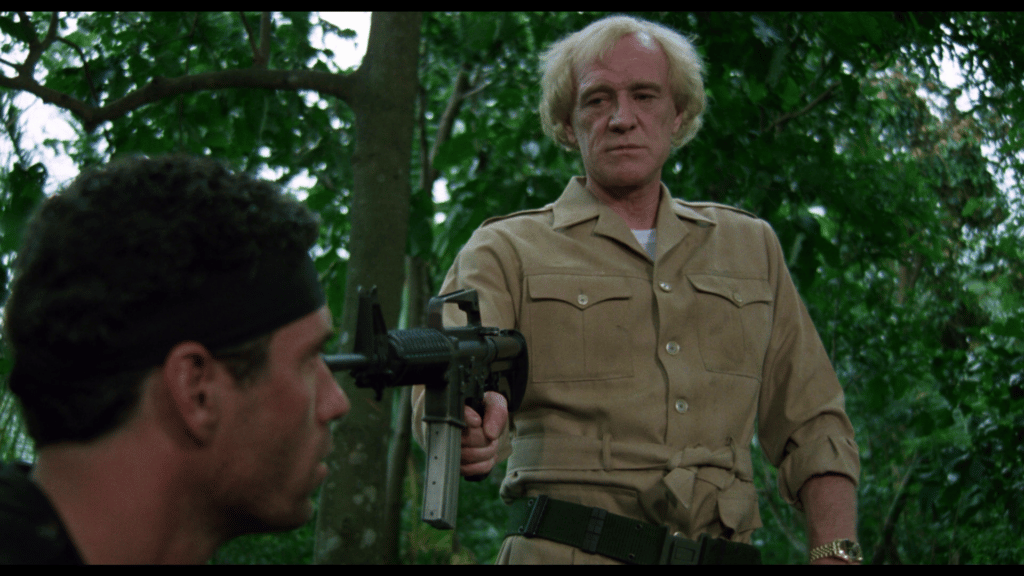
Though clearly inspired on a superficial level by Rambo: First Blood, Part II (the key reference point for the first Strike Commando), like a number of other Italian Namsploitation films (Margheriti’s The Last Hunter, for instance), the narrative of Strike Commando 2 bears some overt similarities with Apocalypse Now (or its source, Joseph Conrad’s novella Heart of Darkness). Following the abduction of Jenkins by forces unknown, Ransom accepts the task of finding and ‘rescuing’ Jenkins – who CIA agent Roeg claims is being held by a group implicated in the manufacture of street heroin – and this leads Ransom into the jungle with $10 million in diamonds, the ransom fee demanded by Jenkins’ captors. (Perhaps tellingly, Roeg tells Ransom to bring back Jenkins dead or alive.) However, after ‘rescuing’ Jenkins, Ransom soon becomes aware that this man, who Ransom positioned as a hero and surrogate father, is in fact deeply duplicitous: Jenkins has in fact been orchestrating the heroin operation in the jungle. The film thus positions Ransom as Willard, and Jenkins becomes the narrative’s complex, multifaceted stand-in for Kurtz. (It’s to Richard Harris’ credit that he gives the character a considerable amount of depth through his performance, despite being given very little to work with in the script.)
Foregrounding the inspiration it takes from the Coppola picture, Strike Commando 2 opens with Ransom in a hotel room, in a scene clearly intended as a pastiche of the post-credits scene of Apocalypse Now – in which a drunken Willard (Martin Sheen) trashes his hotel room in Saigon whilst waiting for a mission, fully aware that ‘Every minute I stay in this room, I get weaker, and every minute Charlie squats in the bush, he gets stronger’. In Strike Commando 2, this is reimagined as a scene in which Ransom, a veteran of the Vietnam war, lounges in a hotel room in Manila, reflecting on news of the ‘death’ of his mentor, Vic Jenkins, in a terrorist attack. (Jenkins’ death is communicated to the viewer via the headline of a newspaper, the Manila Bulletin, which is placed on a side-table.) Mattei endeavours to emulate the expressionist lighting of the opening sequence of Apocalypse Now via the use of coloured gels on the lights, and a touch of chiaroscuro.
Interestingly, this scene features the use of the track ‘The Sound of Fear’ – from the soundtrack to Zombi 3 – as diegetic music, playing on a radio in Ransom’s hotel room. (The track is positioned as the film’s equivalent of The Doors’ ‘The End’, though with New Wave stylings and lyrics that make little sense: ‘I don’t want to go in this sick place / I fear there’s something bad’, indeed.) This track was written by Stefano Mainetti for Zombi 3 and performed by a group called Clue in the Crew, which going by their distinct lack of other published recordings, seems to be a band that was cobbled together to record a few tracks on the Zombi 3 soundtrack. After completing Strike Commando 2, Mattei would go on to complete Zombi 3, when the original director, Lucio Fulci, returned to Italy after either falling ill or experiencing unreconcilable cracks in his relationship with the producers – depending on which version of this story is to be believed. (For what it’s worth, on this disc Fragasso comments that ‘the climate [in the Philippines] was hell’, making working there incredibly gruelling for anyone not in the best of health; and ‘Poor Lucio Fulci suffered like hell when he went there to shoot Zombi 3. He wasn’t in the best of health, and that made it even more unbearable’.)
In Strike Commando 2’s opening sequence, Ransom is dreaming of the heroics of combat: and the film’s opening credits play out over an extended flashback in glorious slow-motion, as Jenkins selflessly aids a downed Ransom in the middle of a firefight. Ransom’s reverie is interrupted by his friend, Ruby (Anthony East), who tells Ransom that Jenkins’ death was faked: he is alive and working for the CIA, under the control of an agent named Peter Roeg (Paul Holmes). Meanwhile, Ransom tells Ruby that Jenkins ‘was like a father to me’. Ransom storms into Roeg’s office (at the offices of Norman Hynde – Import/Export) and demands to know the whereabouts of Jenkins, who is being kept in a safehouse in the countryside. Ransom stages an impromptu rescue of Jenkins, but this is interrupted; Jenkins is captured by another group of men, who lift Jenkins from the safehouse using a helicopter. Ransom presumes this group of men are abducting Jenkins, though in reality it seems that they are liberating him from the CIA.
When Ransom finally hears from Jenkins, it is in the office of Roeg and via a videotape that has been sent to the CIA. In it, Jenkins is shown in a seated position, flanked by two men, dressed in black, who hold rifles; their faces cut off by the top of the frame, these men remain impossible to identify. The content and visual paradigms of this tape refer to the hostage tapes of so many incidents of politically-motivated kidnapping during the 1970s – from the Patty Hearst incident to the activities of the Baader-Meinhof Group and the Brigate Rosse – and their representation in narrative cinema: for example, in the films of Costa-Gavras. In the tape, Jenkins urges that his captors are demanding $10 million in diamonds for his return – or Jenkins will be handed over to the KGB. Roeg explains to Ransom that Jenkins is a ‘frozen agent’: a former CIA operative who is no longer active but holds valuable secrets.
Whether intentional or otherwise, Strike Commando 2’s depiction of the CIA interfering quietly in the affairs of other countries, not to mention the double-dealings of CIA agent Jenkins – who for much of the film seems a passive pawn in captivity, passed from proverbial pillar to post, until the final revelation of his utterly selfish motivations – feels very much a part of the late-80s zeitgeist. Earlier in the decade, of course, the US government had – despite a long-expressed refusal to ‘negotiate with terrorists’ – arranged a covert, and highly illegal, arms deal in exchange for the release of seven Americans who were being held hostage by Hezbollah. Whether Ransom’s mission in Strike Commando 2 (exchanging $10 million in diamonds for a potentially hostile ‘frozen agent’ held by a terrorist group with ties to the KGB) was designed to offer, amidst its whizz-bang action sequences, an oblique comment on this era, or whether this was simply a result of Mattei aping films that did intentionally channel some of the feelings of the 1980s towards such issues, is likely to remain an enigma. Nevertheless, there’s some weight in a line delivered by a local police chief, Lee, to Ransom: ‘It is individuals like you who are not desired in this country’, Lee tells Ransom after the latter has been captured following his aborted attempt to free Jenkins from the safehouse on the hill.
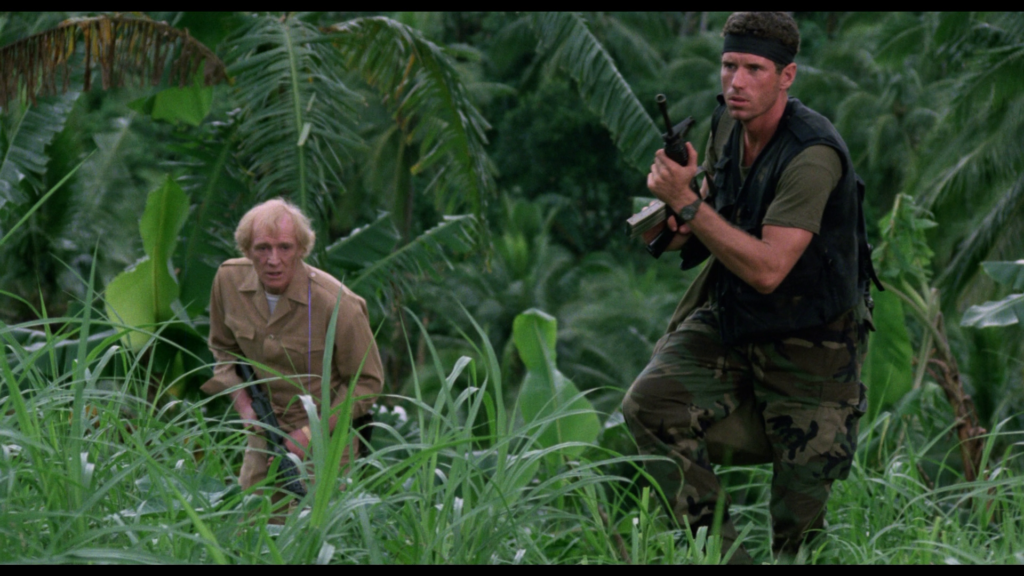
Motivated to make a sequel to the first Strike Commando, a decision was made to up the ante in terms of the film’s budget, and evidence larger production values on screen through the cast. To this end, Richard Harris was chosen to play Ransom’s mentor, Major Vic Jenkins. Harris brings a gravitas to this role; though in the earlier scenes, his performance seems a little telephoned-in, Harris seems to relish the about-turn in Jenkins’ behaviour that comes mid-way through the film: after it is revealed in the plot that Jenkins is in fact a traitor, and has been working against the US government by developing a sideline as a heroin magnate with some vague ties to the KGB, Harris’ performance seems to come alive. His performance is minimalistic, certainly, but after this point, every glance and line seems loaded with a quiet menace. (Huff reveals that in one scene he shot with Harris, he was keen to impress the older actor with his acting chops – only for Harris to tell him afterwards, ‘Cut that in half. It’s too much’. Huff says that ‘He was absolutely right. I learned a lot just from that scene. He saved me’.)
Harris was one of several once-bankable English-speaking actors who at the time were seen as past their prime, and who took work in Italian-produced films photographed in ‘exotic’ places such as the Philippines. Interviewed on this disc, Fragasso suggests that the appeal of such productions was working away from, shall we say, the gaze of the taxman. ‘The difference between Italian and American actors is that the latter aren’t too bothered about a change of scenery […] As long as they get paid, even if it’s under the table’, Fragasso suggests.
Given Harris’ reputation as a heavy drinker, it’s tempting to say that in some scenes, particularly early in the film, he has the clammy-looking brow of the recently-loaded. However, Huff says that Harris ‘wasn’t drinking at the time’ and resisted mingling with the rest of the cast and crew: he ‘didn’t want to be around people drinking’, Huff states. Harris took a hotel room in Manila, whilst the rest of the production team stayed in Pagsanjan: the region in which a filmmaking infrastructure had been built following the production of Coppola’s Apocalypse Now there, and which was used as the base for production of so many Italian exploitation films made in the Philippines. Fragasso has a very different story to tell, saying that soon after his arrival in the region, Harris wanted to talk to Fragasso about his character’s motivations; the two met in Harris’ hotel room in Manila. Whilst holding the conversation, Harris pulled out a suitcase containing 12 bottles of Irish whiskey. The liquid in the bottles ‘was clear, like schnapps’, and Harris explained to Fragasso ‘that it was some special whiskey made by his family’. Harris poured Fragasso a glass ‘while he drank straight from the bottle’. When the first bottle was empty, Harris poured Fragasso another glass whilst he drank straight from the second bottle. Whilst Fragasso was tipsy, Harris ‘was pretty rational’. This continued, and Fragasso says that Harris was as lucid when Fragasso left the hotel as when he had arrived. ‘That was a unique experience, and he was such a smart, well-read man’.
Mattei, as we know, spoke almost no English, making communication with the film’s key cast members on the film set difficult, to say the least. Of course, this hadn’t prevented non-English speaking Italian filmmakers from working with multilingual casts previously: notable examples of Italian filmmakers with a limited grasp of English, but who nevertheless achieved success in directing performances of British and American actors, include, of course, the likes of Sergio Leone, Lucio Fulci, and Dario Argento. On this disc, Brent Huff comments that ‘The fun thing you could do when you have a director who can’t speak English, I could mess up a line, and he’d say, “Print! Fantastic!”’.
Because Mattei spoke such little English, Harris barely communicated with him. However, Fragasso and Mattei soon bonded, Fragasso commenting that ‘It’s the same relationship I’ve enjoyed with Donald Pleasence and a few others’. Interviewed on this disc, Fragasso reveals that Harris needed minimal direction, only small pointers towards his character’s motivation, in order to be able to ‘direct [him]self’: ‘As an actor, Harris was still perfect’, Fragasso says, ‘His delivery was as impeccable as always. He reminded me a little of Giancarlo Giannini’.
Though directing After Death at night, Fragasso was on the set of Strike Commando 2 and functioned ‘more as a directing consultant than an AD [Assistant Director]’: Fragasso directed the actors ‘while Bruno worked more on the technical side’. Fragasso tried to manage the mise-en-scene carefully, ‘despite Bruno’s belief that any flaws could be fixed through good editing’. According to Fragasso, Mattei was committed to the idea that a ‘bad film’ could be saved by the edit: Fragasso was, and remains, of the opposite opinion, believing that ‘No amount of editing could ever save a bad film, whereas a bad edit could never totally ruin a good film’. On this disc, Fragasso suggests that Mattei taught him ‘the tricks of the trade when it came to editing’, and Fragasso learnt a lot from working with Mattei and his ‘more technical attitude’ to filmmaking.
Aside from the film’s obvious allusions to Rambo: First Blood, Part II and Apocalypse Now, Strike Commando 2 draws heavily on Steven Spielberg’s Raiders of the Lost Ark. Ransom’s first encounter with Rosanna takes place in her dive of a bar, which she has named the Moulin Rouge, seemingly out of aspiration rather than a sense of irony. There, she is involved in a drinking competition with a burly local named Hog. The scene clearly imitates the sequence in Raiders of the Lost Ark in which Indiana Jones (Harrison Ford) seeks out his old flame, Marion Ravenwood (Karen Allen), in her bar, The Raven, in Nepal – and finds Marion engaged in a drinking contest with a red-faced Australian climber, Regan (Patrick Durkin). The staging is almost identical, the male and female competitors facing one another over a table. However, where in Raiders of the Lost Ark Marion and Regan are drinking shots of hard liquor (vodka?) until one of them passes out, in Strike Commando 2 Rosanna and her competitor are drinking pints of beer – with the loser being the one who belches first. (And where in Raiders… Marion’s hard-drinking ways pay-off when she out-drinks the lecherous Belloq, enabling her to escape from him, in Strike Commando 2 Rosanna effects a similar escape from Huan To.)
Mel Davidson’s performance as the sinister white-suited, baby-faced KGB agent Svet Kramet, with his Himmler-like round-framed spectacles, is in clear mimicry of Ronald Lacey’s performance as Gestapo agent Toht in the Spielberg picture. However, in Strike Commando 2, Kramet is accompanied inexplicably by black-clad ninjas (presumably present in the film simply owing to Mattei’s desire to tap into another late-80s cinematic fad) rather than Nazi officers. Presumably to underscore his similarities with Toht, Kramet is given some deliriously un-PC lines of dialogue, commenting upon encountering Rosanna for the first time that ‘I’ve never been sure whether women are stupid because they are courageous, or whether they are courageous because they are stupid’. Later, a chase between Kramet and Rosanna results in the latter being cornered by the former. ‘So now you’re gonna rape me, right?’, Rosanna says, ready to fight back. ‘I hate women’, Kramet responds, ‘Yeah? I have a lot of gay friends too’, Rosanna quips. ‘I hate queers’, Kramet adds impassively.
Kramet, it seems, is some kind of sadist, preferring to garrot his victims: perhaps in a quiet reference to Robert Shaw’s Donald ‘Red’ Grant in From Russia with Love (Terence Young, 1963), Kramet’s first onscreen victim, Ruby, is garrotted by Kramet whilst the two men travel on a train. When Ransom is captured by Jenkins, he is tortured at the hands of Kramet, who uses a branding iron. Meanwhile, at the same time, Rosanna has managed to sneak into the camp, disguised as a prostitute, and has been taken to Huan To’s cabin, where the sexually sadistic Chinese KGB agent waxes lyrical about the association of pleasure and pain. (Admittedly, there’s something flinchingly unsubtle about the way in which the film uses music of vaguely Chinese origin to underscore the association this scene draws between sexual deviance and Orientalism.) ‘Your [in other words, women’s] relationship with physical pain has something sublime about it’, Huan To tells Rosanna, ‘That combines the two concepts that interest me the most. Pleasure and pain. Pain and pleasure’. The crosscutting of these two scenes – Kramet’s torture of Ransom, and Huan To’s overtly sexual come-ons to Rosanna – draws a parallel between the characters of Kramet and Huan To, giving the sadism of Kramet a subtly sexual edge which, in the context of his earlier comments to Rosanna, suggests a displacement of any sense of sexual desire onto very intimate acts of violence. (Perhaps, in retrospect, Mattei’s emphasis on the importance of editing had more than a little justification.)
When Ransom finally escapes and turns up to rescue Rosanna, who has already overpowered Huan To, he is faced with a ninja who displays his mastery of form by waving a katana energetically. Predictably, in homage to one of the most famous sequences from Raiders of the Lost Ark, Ransom refuses to engage the ninja in honourable combat and instead shoots him with the belt-fed machine gun which he (Ransom) is carrying. If one were to select a scene from Strike Commando 2 that most effectively captures the manner in which the picture offers a mash-up of Rambo and Raiders, this would be it.
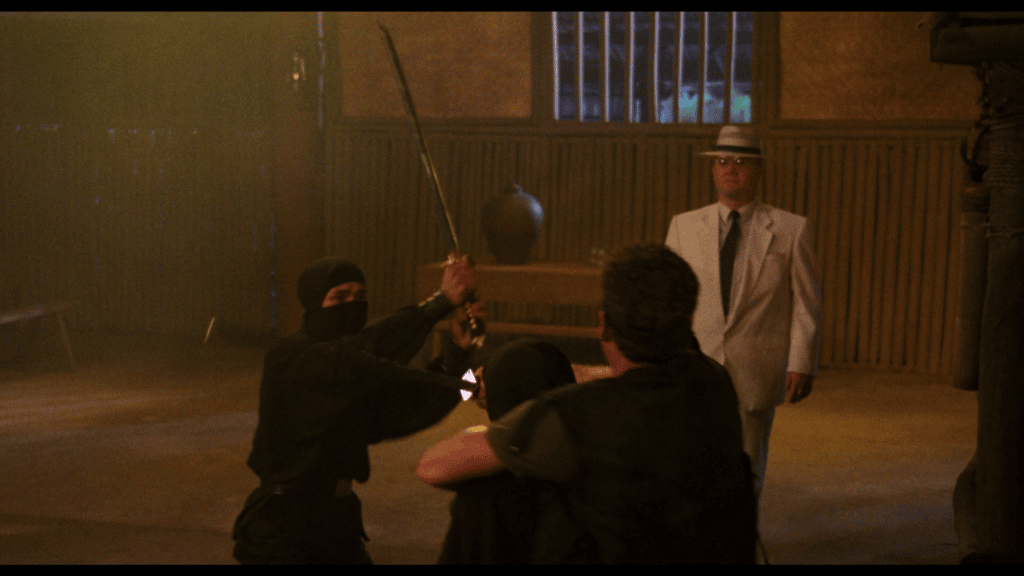
This is followed by an extended sequence in which Ransom and Rosanna escape from the compound in a truck, as ninjas climb on the outside of the vehicle and attempt to enter the cab. Yet again clearly inspired by Raiders of the Lost Ark – notably the sequence in which Indiana Jones steals the truck which is carrying the Ark of the Covenant from the Well of Souls, whilst fending off attacks from German troops – this scene admittedly features some excellent fight choreography and stunt work, though on a much smaller scale than its model. At one moment, the truck hits some scaffolding on which several workmen stand, and in the interviews on this disc both Huff and Fragasso highlight this stunt, saying that one of the Filipino stuntmen broke his leg quite badly during its filming.
The pairing of Huff and Mary Stavin has more echoes of the casting of Kate Capshaw alongside Harrison Ford in Indiana Jones and the Temple of Doom (Spielberg, 1984). Like that film, Strike Commando 2 features numerous jarring tonal shifts. The sombre is juxtaposed with the absurd. In one scene, Ransom sneaks into Huan To’s camp and dispatches a guard using a fighting style that seems derived from Bud Spencer / Terence Hill comedies (or perhaps the Three Stooges): a poke to the eyes, a double ear clap, and the coup de grâce – a bonk on the head. Meanwhile, the bond between Jenkins and Ransom is reinforced time and time again, its reassertion developing into something profoundly pathological. Jenkins expresses certainty that Ransom, who owes the older man his life, will not kill him; Ransom states repeatedly that he sees Jenkins as a father figure. When Ransom springs Jenkins from Huan To’s compound, Jenkins reminds Ransom of the Strike Commando motto, ‘All for one and one for all’. Ransom, it seems, is committed to heroic selflessness (‘I don’t like being back in combat again, having to kill’, he tells Jenkins, ‘But if a man like you is at stake I’m prepared to do it’), which is ultimately tainted by his realisation of Jenkins’ betrayal – of both his country and, on a personal level, Ransom. When Ransom asks Jenkins why he ‘had to get me mixed up on all of this’, Jenkins tells him: ‘Because you’re special, that’s why. Part of a dying breed. Fearless and thoughtless heroes. You owed it to me. I saved your life, so you had to save mine’. ‘What happened to you?’, a disbelieving Ransom asks. ‘I woke up’, Jenkins answers.
Severin Films’ Blu-ray release of Strike Commando 2 is presented on a disc that is locked for playback in region ‘A’ players only. The film’s 1.85:1 aspect ratio is preserved, and the 1080p presentation utilises the AVC codec.
Sourced from a 2k scan of the film’s original negative, the HD presentation is very good. A pleasing level of fine detail is present throughout, most noticeable in close-ups. Contrast levels are nicely-balanced, with a delineated curve into the toe, where shadow detail has texture. The colour palette is naturalistic (aside from a few sequences that feature expressionistic use of coloured gels on the lights). There is limited damage present: a few vertical scratches can be seen, and there is one moment in the film in which a hair caught in the aperture gate dances about at the bottom of the frame. As is expected from a Bruno Mattei film, there is some noticeable use of stock footage from varying sources, from different film gauges. Organic film grain is present. Sometimes this seems very slightly muted, perhaps owing to the encode, but taken as a whole this is a very pleasing, filmlike presentation of the film.
Two cuts of the film are included on the disc: the theatrical cut, running for 90:18 mins; and an extended cut, running for 96:08 mins. The extended cut contains some small additions – most notably, an extension of the sequence in which Ransom infiltrates Huan To’s compound. (Ransom spots some of the compound’s guards in a hut with girls, which sets up the sequence in which Rosanna masquerades as a prostitute to gain entry to the compound, and is spotted by a guard before taking him out in the aforementioned Bud Spencer / Terence Hill-style of fighting.)
Audio is presented via a LPCM 2.0 track in English, and a LPCM 2.0 track in Italian. As with Severin’s release of the first film, the scenes in the extended cut feature audio which is noticeable more compressed, perhaps sourced from a tape. Other than that, both audio tracks are very strong, evidencing pleasing range and depth, especially in action scenes featuring gunfire. (That said, the Italian track sounds very slightly louder, and with very slightly less range than the English audio track.) The film seems to have been shot with the entirety of the cast speaking English, so the English track is arguably the best way to watch this film. Optional subtitles for the Hard of Hearing are included: these are based on the English audio. (Translated subtitles for the Italian track would have been an added bonus.)
As contextual material, the disc includes: the film’s trailer (2:40); ‘Michael Ransom Strikes Back’, an interview with Brent Huff (14:29); ‘Guerrilla Zone’ (16:40), an interview with Claudio Fragasso.
In his interview, Huff discusses how he came to be cast in Strike Commando 2. He had met with a casting director for lunch in LA, and was offered the part in Strike Commando 2 on the spot. He was persuaded to work on the film after discovering Richard Harris was to be his co-star. Though Mattei could not speak English, Huff ‘loved working with him. I’ve got nothing but good things to say about Bruno’. Huff also formed a seemingly lifelong friendship with Mary Stavin, the former Miss Sweden and Miss World (1977), who, Huff says, was very willing to participate in the action scenes, and during the evening would stay up all night playing blackjack.
Huff found the stuntwork tiring but rewarding. He enjoyed shooting the M16s and M60s, reflecting that in US productions, ammo is expensive and limited by the budget, but on the set of this film, ‘I’m shooting all the ammo you can shoot [….] They would let me just empty everything’. Huff found it amusing that the Filipino stuntment would insist on ‘doing a backflip and then they die’ after being shot on screen: ‘It’s so over the top and campy, but it’s like… I think that’s what it’s supposed to be’.
Huff discusses a fight scene he was asked to shoot in the pool outside the safehouse in which Harris’s character is being held in the film’s early sequences. The scene didn’t make the final cut of the picture, but the water was stagnant, resulting in Huff being hospitalised. For a time, Mattei and the producers worried that the production would be shut down. During his stay in hospital, a doctor asked after Huff’s wife, and when Huff told the doctor that he wasn’t married, the doctor left – only to return later with his two daughters, telling Huff ‘They’re not married either’.
A wonderfully modest interviewee, Huff seems enamoured with his experiences making Strike Commando 2, saying that ‘I’d do it again in a heartbeat. Couldn’t have been a better experience’.
The interview with Claudio Fragasso takes place in the same edit suite in which Fragasso was interviewed about his work on the first Strike Commando, presumably from the same session.
Fragasso talks about the origins of Strike Commando 2 – how he, Mattei and producer Franco Gaudenzi, were inspired to make the film after the commercial success of Strike Commando. This resulted in a bigger budget for Strike Commando 2 (about three times the budget of the first picture), much of which went into the casting – including acquiring Richard Harris to play Vic Jenkins. (Fragasso describes Brent Huff as ‘Not that much of a thespian, but quite physically fit’.)
The Filipino stuntmen were fearless and would do ‘insane things’. There were times when Mattei and Fragasso feared that one of the stuntment had been killed in a stunt – including the truck scene which Huff mentions in his interview, and the leap off the waterfall at the climax of their later collaboration, Robowar – which was 35 feet into the water below and needed to be carefully co-ordinated. The film’s stunt co-ordinator, Ottaviano Dell’Acqua, thought this wasn’t possible, but a Filipino stuntman complied and completed this highly dangerous stunt not once but three times.
Though Strike Commando 2’s budget was considerably higher than that of the first film, the picture wasn’t as successful. Fragasso and Mattei concluded that this was because they had tried to make a film ‘too American with a budget that was too Italian. The first one had more soul, with the relationship between Reb Brown’s character and the little boy. It was more Italian, in that respect. The second was more like an American action movie, without the same kind of budget they had, unfortunately. The decline of Italian cinema began when we started actively trying to emulate their [the American] productions’, Fragasso suggests, ‘We just couldn’t win that one, as their B-movies had way bigger budgets than ours [….] That’s how our slow but steady decline began. In the end, our genre cinema hit rock bottom’.
Strike Commando 2 is, like most of Mattei’s output, a picture that indisputably apes the paradigms of popular Hollywood blockbusters of the era, wearing its influences on its sleeve and adopting an ‘everything but the kitchen sink’ approach to its storytelling and iconography. The original Strike Commando found an audience on VHS, particularly, where Strike Commando 2 struggled. However, for those who – as this writer does – love Mattei’s films, Strike Commando 2 is a delight and arguably more entertaining than the first picture. (Being a fan of Richard Harris’ screen work probably helps in this regard, and Harris gives a great performance in this, particularly in the scenes following the revelation that Jenkins is working for the other side.) Strike Commando 2 is a bag of cliches and moments of quiet absurdity: when Ransom first encounters Roeg at the offices of Norman Hynde – Import/Export, the CIA agent he is sitting in front of a series of nonsensical-looking charts bearing trite business phrases (‘5 Year Performance Progress’) to suggest a connection between data-minded bureaucracy and espionage. That said, these cliches all pull together to form a film that intersects in fascinating ways with the zeitgeist of the era, offering offhand commentary on policies of interventionism, and distorted echoes of an era of politically-motivated violence that often intersected with the trade in illegal narcotics. Mattei’s reliance on a grab bag of influences results in a picture that almost perfectly encapsulates the era, in all its absurdities.
Severin Films’ Blu-ray release of Strike Commando far and away exceeds any other home video presentation of this film. The main presentation is very, very good, with the option of two cuts of the picture. The contextual material on the disc – the interviews with Huff and Fragasso – are illuminating and entertaining too. Like Severin’s release of Strike Commando, this is an essential release for fans of Mattei, Namsploitation, or macaroni combat pictures more generally.
For more information, including how to buy a copy of Strike Commando 2, please click here.
